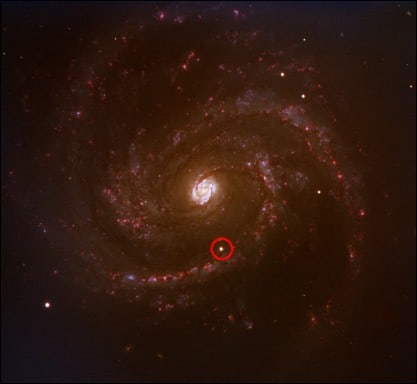A spectacular supernova witnessed last year was fuelled by matter streaming in from a nearby red giant star, according to astronomers in Europe, Japan and the US. The discovery, which was made using the European Southern Observatory's Very Large Telescope, could help in understanding exactly why some stars end their lives in such a dramatic way (Science Express doi:10.1126/science.1143005).

Type Ia supernovae are thought to be produced when the gravitational pull of a white dwarf star draws in enough material from its surroundings to begin nuclear fusion on a large scale, exploding the star into a fleeting object as bright as a billion Suns.
Astronomers had thought these relatively-common events all gave off the same amount of light. As a result, they have been used as “standard candles” for judging distances across the cosmos.
In the last decade, however, astronomers have noticed that there are actually small fluctuations in the brightness of these supernovae, which could affect the reliability of distance estimates. To predict where these deviations arise from, and so make allowances for them, we require a better understanding of what supplies a white dwarf with the extra material.
Now, Ferdinando Patat of the European Southern Observatory (ESO) in Germany together with co-workers from Europe, Japan and the US has used a new technique to find that one type Ia supernova collects its material from a nearby “donor” star in the red giant phase, thus confirming a popular theory of supernovae formation.
The measurement exploited the fact that donor stars expel material in all directions – some goes to fuel the supernova, while some comes between the supernova and our viewpoint on Earth. As light from the supernova travels to a telescope on Earth, this latter material absorbs certain wavelengths, leaving gaps or “absorption lines” in the observed spectrum.
The denser the material present, the stronger the absorption lines will be. However, the absorption is also affected by the physical condition of the supernova, which changes with the amount of material it acquires from the donor star. This two-way relationship causes variations in the strength of the absorption lines over time.
Patat’s team used the ESO’s Very Large Telescope (VLT) in Chile to search for the strength variation in the sodium absorption lines of the supernova 2006X over four different periods in its lifetime. Because of the VLT’s eight-metre diameter and the number of observations, they were able to calculate the variations in the density of the sodium material in unprecedented detail. “This had never been attempted before,” Patat told Physics Web. “It was commonly believed that no variations should be seen in the inter-stellar absorptions.”
In addition to variations in density, the researchers calculated variations in the speed of the expelled sodium by looking for the blue Doppler shift in the wavelength of the absorption lines – an effect that arises because the waves appear “compressed” when they are travelling towards an observer.
Patat’s team claim that both these measurements point to a donor star in the red giant phase, which is known for expelling material in patchy “shells”. “The red giant steadily loses material, but has some hiccups, so to speak,” Patat said. This goes against another theory of type Ia supernovae that involved two white dwarfs merging.
The researchers’ finding will help astronomers to use these standard candles more accurately, but Patat points out that it does not rule-out other type Ia supernova theories yet. “Supernova 2006X is only one object,” he added. “We will need much more data to tell if this is the rule rather than the exception.”



